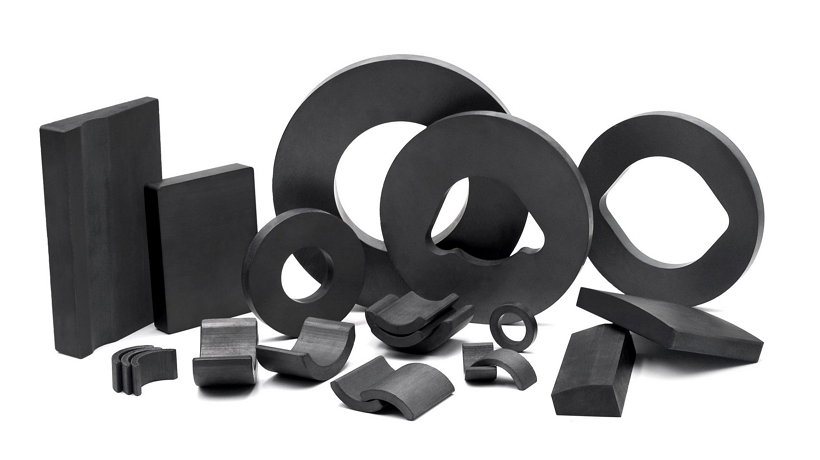Introduction
Magnets are everywhere—holding up your grocery list, powering your speakers, even spinning the motors in your car. But while flashy Neodymium magnets and rugged SmCo magnets often steal the spotlight, a quieter player in the game is hard ferrite magnets. These unassuming permanent magnets might not scream strength, but they pack a punch where it counts—durability, affordability, and versatility. So, what's the deal with hard ferrite magnets? Why should you care? Let's dive in and uncover what makes these magnets tick, sprinkle in some real-world examples, and figure out where they shine (and where they don't).

What Are Hard Ferrite Magnets, Anyway?
Hard ferrite magnets—sometimes called ceramic magnets—are a type of permanent magnet made from a mix of iron oxide (think rust) and either barium or strontium carbonate. Sounds simple, right? That's because it is. Manufacturers heat this blend to a scorching 1,000°C or more, shaping it into a tough, brittle material with a magnetic charge like a champ.
Hard ferrites, unlike rare-earth stars like Neodymium magnets, don't rely on scarce elements. That keeps costs low and availability high. Their magnetic domains—tiny regions acting like mini-magnets—align during production to create a steady magnetic field. The result? A reliable, no-frills magnet ready for action.
Why Hard Ferrite Magnets Stand Out
So, what's the big deal? Hard ferrite magnets have a unique combination of traits that make them a go-to in many applications. Here's the rundown:
1. Tough as Nails Against Corrosion
Unlike Neodymium magnets, which rust if their coatings fail, hard ferrites laugh off moisture and chemicals. Their ceramic makeup means they don't need fancy protective layers—toss them into a damp environment, and they'll keep trucking.
- Example: Picture a fridge magnet in a humid kitchen. A hard ferrite version stays strong, while a poorly coated Neodymium magnet might start flaking.
2. Heat? No Sweat!
These magnets handle heat better than many alternatives. Their Curie point—where magnetism vanishes—sits around 450°C (842°F). That's not as high as SmCo magnets (750°C+), but it's plenty for everyday use.
- Practical Tip: Use hard ferrite magnets in car engines or ovens where temperatures climb, but don't hit aerospace extremes.
3. Wallet-Friendly
Let's be real—cost matters. Hard ferrites are dirt cheap compared to rare-earth options like Neodymium or SmCo magnets. That makes them a favourite for mass-produced goods where every penny counts.
- Fun Fact: A single hard ferrite magnet might cost cents, while a Neodymium magnet of similar size could set you back a few bucks.
4. Decent Strength, Not Super Strength
Okay, they're not breaking records. Hard ferrites max out at about 4 MGOe (megagauss-oersteds, a measure of magnetic energy), while Neodymium magnets hit 50 MGOe or more. But for lighter tasks, their strength is just right.
Where You'll Find Hard Ferrite Magnets in Action
These magnets might not flex the raw power of Neodymium or the heat resistance of SmCo magnets, but they've carved out a sweet spot in the world. Here's where they shine:
1. Electric Motors and Generators
Small toy motors, fans, and power tools rely on hard ferrite magnets. They provide steady magnetism without jacking up production costs.
2. Speakers and Audio Gear
How do budget loudspeaker pump out sound? Hard ferrite magnets drive the vibration in speaker cones, balancing quality and price.
3. Everyday Gadgets
From fridge magnets to magnetic latches on cabinet doors, hard ferrites are the unsung heroes of daily life. They're simple, sturdy, and get the job done.
4. Automotive Bits
In cars, they pop up in windshield wiper motors, window regulators, and even starter motors—places where reliability trumps raw strength.
The Flip Side: Where Hard Ferrites Fall Short
No magnet's perfect, and hard ferrites have their quirks. Here's what to watch out for:
• Brittleness: Drop one, and it might chip or crack. They're tough against rust but fragile under impact—unlike the more durable SmCo magnets.
• Lower Strength: If you need serious lifting power, say for industrial machinery, Neodymium magnets leave hard ferrites in the dust.
• Size Matters: To match even a fraction of a rare-earth magnet's pull, hard ferrites need to be bigger, which can be a design headache.
So, while they're champs in some areas, they're not the all-purpose fix. Know your needs before picking one!
How Do They Stack Up Against the Competition?
Let's put hard ferrite magnets side-by-side with their flashier cousins:
Vs. Neodymium Magnets: Neodymium wins on strength—hands down. But hard ferrites beat them on cost and corrosion resistance. Need power? Go Neodymium. Need cheap and cheerful? Hard ferrite's your pick.
Vs. SmCo Magnets: Samarium-Cobalt magnets handle insane heat and resist wear better, but they're pricey. Hard ferrites offer a budget-friendly alternative for less extreme conditions.
Vs. Alnico Magnets: Alnico has a vintage vibe and decent heat tolerance, but hard ferrites edge out on cost and modern versatility.
It's all about trade-offs. Hard ferrites deliver where affordability and reliability matter most.
Keeping Hard Ferrite Magnets Happy
Want your hard ferrite magnets to last? They're low-maintenance, but a few tricks keep them in top shape:
Avoid Hard Knocks: Store them carefully to dodge cracks. A padded box works wonders.
Mind the Heat: They're heat-tolerant, but don't push past 450°C unless you want a paperweight.
Pair Wisely: Don't stack them near stronger magnets like Neodymium—those domains could get scrambled.
Treat them right, and they'll stick around for years.
Why Hard Ferrite Magnets Deserve More Love
Hard ferrites might feel like the underdog in a world obsessed with high-tech Neodymium and SmCo magnets. But that's their strength—they don't need to show off. They quietly power the gadgets we take for granted, proving that sometimes simple is best. Whether it's a kid's toy or a car part, these permanent magnets deliver without breaking the bank.
Ready to dig deeper into the world of magnets? Check out more insights on our site for tips, guides, and the latest on permanent magnets. Want to know how Neodymium stacks up or why SmCo magnets rule extreme conditions? We've got you covered—head over and explore!
Q&A: Your Hard Ferrite Magnet Questions Answered
Q: Are hard ferrite magnets weaker than all other permanent magnets?
A: Not quite! They're weaker than rare-earth options like Neodymium and SmCo magnets but hold their own against some older types like Alnico in specific uses. It's about the right tool for the job.
Q: Can hard ferrite magnets rust?
A: Nope! Their ceramic nature makes them naturally corrosion-resistant—no coatings needed, unlike Neodymium magnets.
Q: Why are they called "ceramic" magnets?
A: It's all in the process. They're made by sintering iron oxide and carbonates into a ceramic-like material—hard, brittle, and magnetic.
Q: How long do hard ferrite magnets last?
A: Decades, usually! Under normal conditions, they lose strength super slowly—think 1% over a century if nothing messes with them.
Q: Can I use hard ferrite magnets in high-tech gear?
A: Sometimes, but not always. They're great for basic motors or speakers, but cutting-edge tech often demands the oomph of Neodymium or SmCo magnets.
Post time: Apr-17-2025
